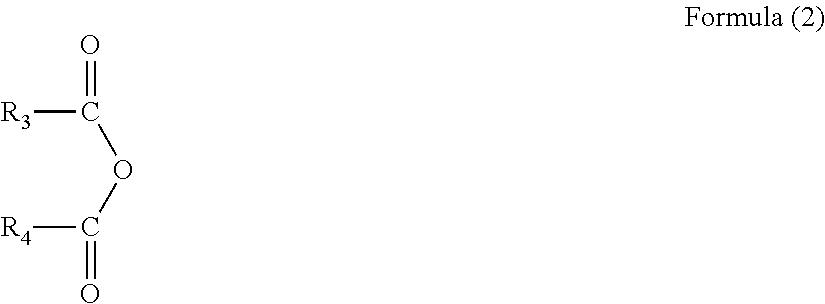Colloidal silica particles, process for producing the same, and organic solvent-dispersed silica sol, polymerizable compound-dispersed silica sol, and dicarboxylic anhydride-dispersed silica sol each obtained from the same
a technology of colloidal silica and silica, which is applied in the field can solve the problems of aggregation or gelation of colloidal silica particles, and achieve the effects of high silica concentration, large electrostatic repulsion, and high silica concentration
- Summary
- Abstract
- Description
- Claims
- Application Information
AI Technical Summary
Benefits of technology
Problems solved by technology
Method used
Image
Examples
reference example 1
[0120]To a 100 L plastic container, 9.6 kg of a sodium silicate solution (manufactured by Fuji Kagaku Corp., No. 3 sodium silicate, a SiO2 concentration of 29.1% by mass, a SiO2 / Na2O molar ratio of 3.2, and an Al2O3 / SiO2 molar ratio of 0.0003) and 60.2 kg of pure water were placed and stirred so as to be homogeneous. To the diluted sodium silicate solution, 1.98 kg of an aqueous solution of sodium aluminate (an Al2O3 concentration of 1.0% by mass and a Na2O concentration of 0.77% by mass) was added with stirring with a disper, and the whole was stirred for 30 minutes. The obtained aqueous solution was passed through a column filled with 24 L of a strongly acidic cation-exchange resin in the hydrogen form (Amberlite (registered trademark) IR-120B, manufactured by Organo Corporation) to give 70.0 kg of an activated silica solution (a SiO2 concentration of 3.7% by mass and a pH of 2.8). To a 100 L stainless steel container with a reflux condenser, a stirrer, a heater, and a pouring hol...
reference example 2
[0121]To 4000 g of the acidic silica sol 1a obtained in Reference Example 1, 74.0 g of a 10% by mass aqueous sodium hydroxide solution was added to alkalify the sol (a pH of 9.2), and then the hydrothermal treatment was carried out on the sol with a 3 L stainless-steel autoclave container at 205° C. for 2.5 hours to prepare an alkaline silica sol 2. The hydrothermal treatment was carried out twice on each 2000 g of the alkalified sol. The obtained alkaline silica sol 2 had a SiO2 concentration of 25.0% by mass, an average primary particle diameter of 22 nm, and a pH of 10.3. Through a column filled with 500 mL of a strongly acidic cation-exchange resin in the hydrogen form (Amberlite IR-120B), 4000 g of the alkaline silica sol 2 was passed to give 4000 g of an acidic silica sol 2a (a SiO2 concentration of 25.0% by mass, an average primary particle diameter of 22 nm, a pH of 2.5, an average content of the polyvalent metal element M: an M / Si molar ratio of 0.0027, the polyvalent metal...
example 1
[0123]In a 3 L polyethylene jar, 2000 g of the acidic silica sol 1a (an average primary particle diameter of 12 nm, SiO2 of 25.0% by mass, a pH of 2.8, an average content of the polyvalent metal element M: M / Si molar ratio of 0.0028, the polyvalent metal element M in the surface of the particles of 0.020 atom / nm2, and a zeta potential of −24 mV) obtained in Reference Example 1 was taken. With stirring using a disper at 1000 rpm, 96.0 g of 10% by mass sulfuric acid was added to the sol, and then the whole was stirred for 10 minutes. The obtained silica sol had a pH of 1.2. The sol was left at 23° C. for 24 hours, and then passed through a column filled with 100 mL of a strongly acidic cation-exchange resin in the hydrogen form (Amberlite IR-120B), a column filled with 250 mL of a strongly basic anion-exchange resin in the hydroxy form (Amberlite IR-410), and a column filled with 50 mL of a strongly acidic cation-exchange resin in the hydrogen form (Amberlite IR-120B) in this order ov...
PUM
| Property | Measurement | Unit |
|---|---|---|
| average primary particle diameter | aaaaa | aaaaa |
| pH | aaaaa | aaaaa |
| particle diameter | aaaaa | aaaaa |
Abstract
Description
Claims
Application Information
 Login to View More
Login to View More - R&D
- Intellectual Property
- Life Sciences
- Materials
- Tech Scout
- Unparalleled Data Quality
- Higher Quality Content
- 60% Fewer Hallucinations
Browse by: Latest US Patents, China's latest patents, Technical Efficacy Thesaurus, Application Domain, Technology Topic, Popular Technical Reports.
© 2025 PatSnap. All rights reserved.Legal|Privacy policy|Modern Slavery Act Transparency Statement|Sitemap|About US| Contact US: help@patsnap.com



